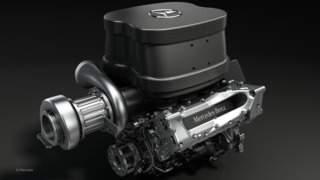The Unofficial Alt+F1 Beginner's Guide to Formula 1! — Recap + 2014 Changes
By aurahack 2 Comments

2013 was a year of conflicting opinions, due mostly to the continued victory streak of long-time winner Sebastian Vettel and the Red Bull Racing team. With pre-season knowledge that 2014 was to bring entirely new engine and chassis regulations, several manufacturers weighed their options: do they go full-in with R&D on this season’s car, or do they save up on costs in wait of developing for 2014.
This conundrum posed difficulties for several teams, the most glaring of which being McLaren. McLaren has been one of the sport’s most victorious and top-tier teams for decades, yet 2013 saw them take an incredibly hard slap to the face. Their star driver from 2012, Lewis Hamilton, left for another team and McLaren opted to hire Sergio Perez, a rookie who showed promise in the previous season. This ended up being a risk that didn’t pay off for McLaren, however. In addition to having a car that simply could not perform up to par with the rest of the grid’s top teams, Perez didn’t deliver on the promise he initially had.
The season proved difficult for many teams, with the likes of Sauber, Williams, and Force India all scoring well under what they had expected. Mercedes, however, fared incredibly well during the 2013 season. Though they faced a mediocre 2012 season, 2013 brought a number of wins and pole positions to the team—something that surprised most fans. Like the 2012 season, F1’s 2013 season was also rife with controversy regarding its tires. A series of explosions during the Silverstone race raised a number of alarmed concerns and questions, with severe blame being thrown at F1’s sole tire manufacturer, Pirelli.
While a competitive ground was present in the first half of the season, the second half brought an unrelenting assault from Red Bull Racing and its three-time championship winner Sebastian Vettel. They won the last 10 races, slowing down the pace of competition by a considerable amount. Some teams had clearly given up, while some drivers saw it as a chance to say “fuck it” and go for broke. This led to some boring racing up front, but incredibly competitive and aggressive racing mid-pack. The race outcomes led to a divide between fans, with some arguing Vettel turning the sport into a snoozefest. Others argued against, saying the rest of the grid remained as competitive as ever.
With a 151-point lead, Sebastian Vettel ended the 2013 season in Brazil with his fourth consecutive Driver’s Championship title.

Formula 1 will see a host of new changes, the most important of which being with the cars themselves. I’ll try to keep most of the detail out, partially because I am not an engineer and really can’t tell you why KERS is now ERS-K.
New Engines

For the first time since 1988, Formula 1’s engines will now be turbocharged. The new, smaller engines are meant to be more efficient as well as more durable, with regulations requiring them to last twice as long in use versus last year’s.
Last year’s announcement that 2014 would see turbocharged engines came with its share of criticisms. A lot of fans perceived the smaller engines as a sign of the sport going soft and bending towards “greener” tendencies, which they saw as a contrast to Formula 1's reputation of being the peak of automotive engineering.
New Cosmetic Changes — The Low Noses

With new engines comes new cosmetic regulations, such as changes to have larger air intakes and wider side-pods. The most noticeable change this year comes in the shape of low noses, a change encouraged for safety reasons. The strange angle required by FIA (Formula 1’s governing body) regulations has left every team in an extremely experimental spot with nearly every car sporting a different nose configuration.
FIA regulations for a car’s design are extremely strict, so it’s rather surprising to see a host of different noses on the cars this year. The objective of the car’s design is to make it as aerodynamic as possible with as much downforce as possible, so it will be interesting to see what designs work best for the teams.
KERS/ERS-K/ERS/ACRONYMS

KERS, a system introduced into the sport a few years ago, will see changes this year as well. KERS, which stands for Kinetic Energy Recovery System, is a device separate to the car’s engine that would store kinetic energy released from braking into a “battery”, which could then be re-used as a boost during a race. Each lap, the driver would be allotted a set amount of “energy” to use during a lap, with the allotted amount resetting back to full on a new lap.
This year, KERS is being renamed to ERS-K, and is seeing a change in its design. It is now integrated into the engine itself and will also capture heat dispelled from the turbochargers in the engine, which can then be re-used as a boost similar to the former KERS setup. However, unlike last year, KERS' integration into the engine means that a manual boost is no longer required—the engines are automatically "boosted" by pressing down on the throttle. The older function of KERS, pressing a button to activate it, remains for overtaking.
The biggest change comes to its use time, however. Formerly, KERS could only be used for a total of six seconds during a lap and would output an extra 80 hp. This year, it will output 161 extra hp and can be used for a total of 33 seconds per lap. This is close to a third of a lap on most tracks, (with more than a third on shorter tracks) so ERS-K will see far more use in this year’s season than in previous seasons.
Penalty Points
In an effort to encourage increased safety while racing, penalty points will be introduced this season. Penalty Points will be assigned to drivers when a penalty is given to them during a race and once a total of 12 points has been amassed, the driver will be given a one-race ban. After the ban, the driver will then start with 5 points already on their profile, as to further discourage rule breaking/reckless driving.
More Points
Though this will only come into effect at the end of the year, the final race of the calendar will now offer double points to the top 10 racers. This has been introduced to help keep the championship fight alive should a certain driver somehow manage to amass a considerable lead in points over the season.
~
